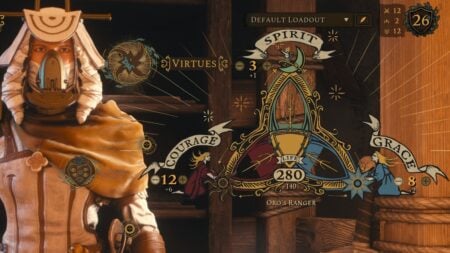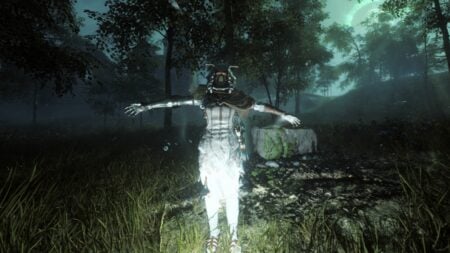Skip To...
The Lord of the Rings has been a beloved series for many people worldwide. Of all the media that have come out of the original material, the movies stand out as some of the best. Sadly, we have not fared so well regarding game adaptations of this rich and wide-ranging universe. With the bad taste in the mouth that Gollum left, many people had low expectations for Lord of the Rings: Return to Moria. Fortunately, just as the dwarves found their treasure in the bowels of The Lonely Mountain, we, as gamers, have found the treasure we longed for in Moria.
Lord of the Rings: Return to Moria Review: Once More Into Khazad-Dûm

Of all the genres I could ever imagine for a modern Lord of the Rings game, survival crafting never crossed my mind. Where the movies and other adaptations have focused on the epicness of large-scale fights and unbridled action, Return to Moria focuses on something we sometimes forget is a crucial part of this series — exploration.
Story: The Fellowship of the Beard

With a call from Gimli, voiced by John Rhys-Davies, you and other dwarves are summoned to Moria to reclaim this place, now in ruins and full of dangers. When I started my game after creating my Dwarf, I could not help but feel like Bilbo in the iconic scene where he shouts, “I’m going on an adventure!” That, for me, has always been the essence of the series. A company of eclectic characters ready to venture into the nooks and crannies of Middle Earth. And here, although there are no plains or vast landscapes, you can take your company of Dwarves and venture into one of the most iconic locations of the Misty Mountains.
I played my adventure with another person, and as creatively as we could, we named ourselves “The Fellowship of the Beard.” It’s not something the game allows or asks you to do, but we wanted to immerse ourselves. After a straightforward but well-crafted tutorial, you find yourself in the darkness of Moria, where the echo of goblins and orcs travels through the narrow corridors of these dark depths.

Unlike many other survival games, there is a story here. The main quest is to reclaim Khazad-dûm, accompanied or alone. Upon arrival at the site, an accident causes you and up to seven other companions to become trapped. From there, you discover a curse plaguing this ancient kingdom, and it is up to you and your company to fix it all.
While as someone who has read all the books and seen all the movies, I loved the in-game references, what I enjoyed most was the little story I was making with my company of two. Entering a new area generated a feeling of discovery that, as good digital Dwarves, made us look for more treasure to continue descending into the depths of the kingdom.
We discovered deadly creatures, precious materials, gems, and destroyed buildings ready to be fixed. At the end of the day, we didn’t discuss what we learned from the plot. We talked about how a pack of wolves killed us for the fifth time or how we knocked down our walls by mistake. Our storytelling, to me, was more memorable than the game’s plot.
Gameplay: Hammer and Tongs

Lord of the Rings: Return to Moria is a survival crafting game. You have a hunger bar; you need to rest to replenish your energy, manage your inventory, find materials to craft, and dangers that will defeat you and force you to leave all your treasures behind.
Return to Moria has several stages as you play. Explore. Collect. Restore. Crafting. These, for me, are the most essential parts of the game you will experience in each zone. In the beginning, you start in narrow corridors that open up to give way to vast areas full of broken statues and dilapidated buildings. Almost everything in this game has a use. That statue in the distance? You can restore it to obtain armor blueprints. That old forge in pieces? It may have a piece of furniture or item you haven’t gotten yet, and fixing it unlocks it in your repertoire.
It gets better when you realize the perfect pacing of the game. One of the things I hate the most about the genre is when you have a good pace, and suddenly, it stops because you don’t even know what to do, or everything becomes slow to get. That’s not the case here. The main quest guides you to places full of new materials you can quickly obtain to craft something better and keep progressing. The fact that the random maps are somewhat small but have verticality makes everything more essential and impactful. While these games are enjoyable with large maps, for the first time, I’m happy to have something more compact but with things to do.

One thing I still don’t enjoy and hope by Gandalf’s beard that it gets fixed is the combat. I’m aware that Valheim established a somewhat visceral, challenging, and, to some extent, realistic combat style, but in Return to Moria, it feels very floaty. The animations sometimes don’t pack the punch I would hope for. The enemy’s artificial intelligence tends to fail horribly, causing some to disappear or get stuck. Add to that the imbalance of some creatures like the wolves that, despite being underground, spawn faster than the orcs or goblins.
Another element I didn’t enjoy was building. I understand that the game is not open-world and that we are in tighter locations, but why are we being punished for wanting to build a few meters outside of our base? To build, you need a Stone Hearth, which limits your build area, but Sauron forbid we want to make a big base. The building system is somewhat limiting and clunky because of its interface. Although I didn’t expect to build a Dwarven mansion or a giant stone Hobbit, I hated being limited by the space we were given. I got frustrated using the controls, especially when adding beams or columns.
While I feel that Lord of the Rings: Return to Moria gets many things right, it still lacks in many areas. On the one hand, you have fantastic pacing and exploration. Still, on the other hand, combat is one of the most tedious and frustrating things out there because the flaws in the AI add unnecessary challenges. You have many materials used to build things; each one feels impactful. But what’s the point if, beyond creating items, there’s nothing to reward you for creating an original base instead of just putting two walls on a broken building and going to bed?
Graphics and Audio: Middle-Earth’s Dark Depths

The graphics are no big deal, and I appreciate that. Nowadays, we have games that aim for realism, and our computers already have to be on par with NASA’s to run them. Free Range Games has created a memorable style, straight out of the movies and books, and easy to run on many computers. From the corridors of abandoned buildings to the Elven Quarter, full of flora, fauna, and water streams that generate a sense of ephemeral peace before the next wave of goblins. Every piece works perfectly and adds beauty to this desolate place.
The audio was one of my favorite elements of gameplay. If you saw The Fellowship of the Ring, you’ll remember the scene where the orcs are about to invade our heroes. The footsteps of the enemies echo through the halls, and the sound of stones and bones getting crushed with each of their steps. All this is in the game, and the real heroes of this experience are those in charge of creating this level of immersion. I can’t tell you how grateful I am that the audio made me lose myself while building my sword as I listened to a goblin talk about how it would kill me. It gives the game soul and kept me in suspense at every turn.
Conclusion: An Unexpectedly Fun Game

While I didn’t have high expectations for another Lord of the Rings game this year, Return to Moria lit the flame that Gollum had extinguished. With a gorgeous setting and a sense of adventure enhanced by playing with other people, this title is a fun survival crafting experience. Sadly, the game has a lot of bugs, a lack of balance with some creatures, and limits you to build, which is ironic when it is one of the most prominent mechanics of the genre.
For those waiting for a decent survival crafting game, this may be what you are looking for. While the game just launched, I’m excited to see what else the developers add and where they take this new title. And, if other companies are looking to dip their toes into Middle Earth, this formula is something they shouldn’t overlook.
Lord of the Rings: Return to Moria is available now on PS5 and PC (Reviewed).
Review copy given by Publisher.
Lord of the Rings: Return to Moria (PC Reviewed)
A survival adventure in one of the most beloved fantasy settings of all time.
Pros
- A gorgeus and beloved setting for a survival game.
- Superb audio design.
- Smooth multiplayer systems.
Cons
- Several gameplay bugs.
- Limited building mechanics.







